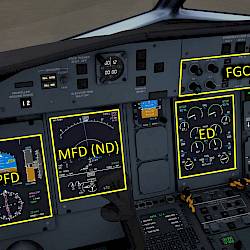
Q400 Flightdeck Introduction
We’re explaining the cockpit instruments, features and functionality of the Dash8-Q400 in our flightdeck guide.
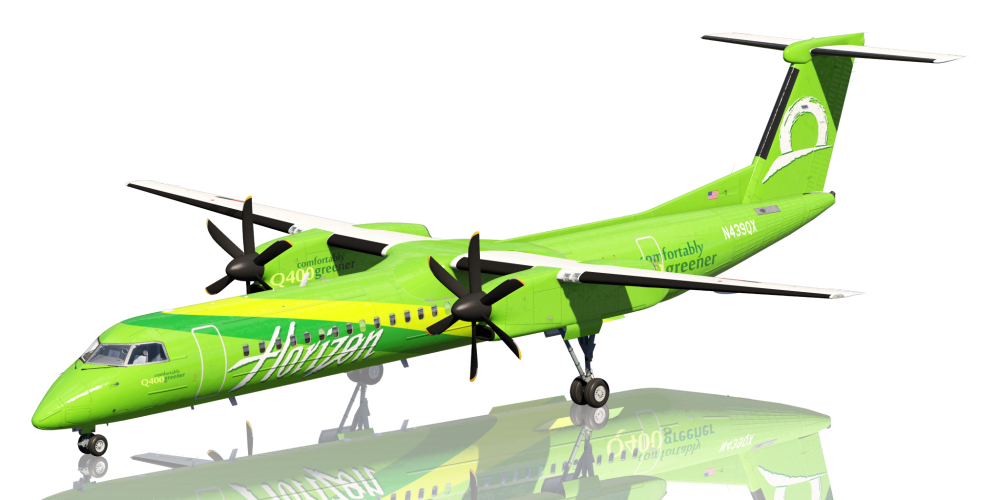
In this tutorial we’re using the Q400 turbo-prop for a short flight from San Diego (KSAN) to Los Angeles (KLAX). We’re taking off from runway 27 towards the Pacific and then turn northbound and cruise along the west coast. During the flight we are going to use the lateral navigation (LNAV) of the flight management system (FMS) and will fly the ILS approach into LAX. The planned route is 103.1 NM long and will take us about 25 minutes. The cruise altitude is going to be 15,000ft and we’re only going to cruise for just a short duration.
Before we continue, it is advisable to read the flightdeck introduction first.

We’re explaining the cockpit instruments, features and functionality of the Dash8-Q400 in our flightdeck guide.

In our special tutorial for the UNS-1 FMS you will learn how to enter a flight plan for the 737-500, LJ45 and Q400 in the cockpit.
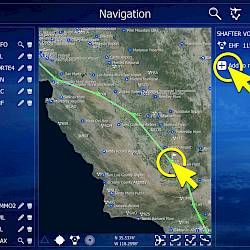
Learn how to use the powerful route planner of Aerofly FS to create a realistic flight plan.
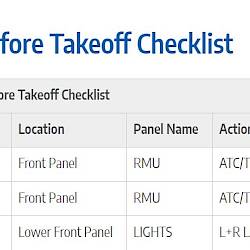
The checklists used in this tutorial can be found on this dedicated page.

KSAN RWY27 SAN NFG ELB KLAX RWY25R
Create the flight plan as follows, either with the Aerofly FS Navigation Menu or using the UNS-1 FMS.
You can set the conditions as you like, we’re going to use runways pointing to the West so wind coming from the West would be best. Suggested conditions are:

We’re starting this tutorial on the south apron of San Diego with engines off in the “Before engine start” configuration. If you like you can skip ahead and use “Ready for taxi” instead.
Location MenuPrior to the flight we recommend setting up a few key commands that we need during this tutorial flight. Please go to the controls menu for the “autopilot” and assign the following functions to keyboard keys or joystick buttons:
We’re going to set the MDA bug to 1500ft over the airfield elevation to know when to transition to the climb phase. The steps necessary for this have already been shown in the introduction to the flightdeck of the Q400, here they are again. For San Diego which is only barely above sea level we’re just going to use 1500ft for the MDA setting.

To enter this altitude as MDA
We have to fly the takeoff manually but we have the option to prepare the flight guidance system in advance to reduce workload in the initial segment right after lift off, where things are very hectic. These steps might all be completed already and you can skip a lot of these steps to prepare the autopilot!

First we will select the FMS1 navigation source on our PFD to have our flight plan available right away. As described in the flight deck introduction these are the required actions on your side to achieve this:
In the control settings of the Aerofly FS there is a control assignment in the autopilot controls for “TakeOff GoAround Button (TOGA)”. Press this button now. If you don’t want to assign this you can also depress the “HDG” pushbutton. Note how the flight director on the PFD came alive and the active lateral mode “WINGS LVL” was selected. The vertical mode “GA” is also activated but the selected altitude is not armed yet. And our selected altitude may be off.

At this point we are not going to engage LNAV, instead we are going to use HDG SEL and the departure runway heading for takeoff.


When all these actions for the autopilot have been completed the primary flight display should indicate the modes “HDG SEL” with a selected heading of 273° in this case, GA as active vertical mode and ALT SEL armed with the selected altitude at 15,000ft for this flight.
If you accidentally pressed the wrong button just press the “STBY” button on the autopilot panel to clear all active modes. Then try again. You could also takeoff with PITCH HOLD as active vertical mode and manually set the 9 degrees pitch up with the vertical wheel. When the autopilot engages it will synchronize the pitch attitude anyway.
If you have selected the “Ready for taxi” configuration then your engines should already be spinning. If you selected the “Before engine start” setting however we now need to start the engines.
| Engine Start Procedure | |||||
|---|---|---|---|---|---|
| No. | Location | Panel Name | Action | Remarks | |
| 1 | Pedestal | Throttle Quadrant | PARKING BRAKE | ON | * |
| 2 | Overhead | EXTERNAL LIGHTS | ANTI COLLISION | ON RED | |
| 3 | Overhead | Signs | EMERGENCY LIGHTS | ARM | * |
| 4 | Overhead | Signs | FASTEN BELTS | ON | * |
| 5 | Overhead | Signs | NO SMOKING | ON | * |
| 6 | Overhead | ICE PROTECTION | ENGINE INTAKE 1&2 | SET OPN | Press each button 1x |
| 6 | Overhead | AIR CONDITIONING | RECIRC | ON | |
| 7 | Overhead | AIR CONDITIONING | BLEED 1&2 | OFF | * |
| 8 | Overhead | APU CONTROL | PWR | ON | Wait for self test |
| 9 | Overhead | APU CONTROL | START | ON | Wait for green RUN |
| 10 | Overhead | APU CONTROL | GEN | ON | |
| 11 | Overhead | APU CONTROL | BLEED AIR | OFF | * |
| 12 | Overhead | DC CONTROL | MAIN BUS TIE | TIE | |
| 13 | Overhead | ENGINE START | IGNITION L&R | NORM | * |
| 14 | Overhead | ENGINE START | SELECT | 1 | |
| 15 | Overhead | ENGINE START | START | PUSH | |
| 16 | Pedestal | Throttle Quadrant | PROP LEVER 1 | START & FEATHER | Wait for starter cut out (50% NH) |
| 17 | Overhead | ENGINE START | SELECT | 2 | |
| 18 | Overhead | ENGINE START | START | PUSH | |
| 19 | Pedestal | Throttle Quadrant | PROP LEVER 2 | START & FEATHER | Wait for starter cut out (50% NH) |
| After Start Procedure | |||||
| No. | Location | Panel Name | Action | Remarks | |
| 1 | Overhead | APU CONTROL | GEN | OFF | |
| 2 | Overhead | APU CONTROL | PWR | OFF | |
| 3 | Overhead | DC CONTROL | MAIN BUS TIE | OFF | |
We’re now preparing the aircraft for taxi and takeoff.


We already set the condition levers to MAX 1020 and we won’t move them until we’re in the climb. We select the engine rating “RDC TOP TRQ” with 4% power decrease for this tutorial. If your runway is short you may want to use full takeoff power, in this case press the MTOP button before takeoff.
On the ENGINE and PROPELLER CONTROL panel in front of the throttle quadrant

In the most left column of the overhead panel set the following switches:
Note - The engine intakes are opened so that foreign object debris (FOD) or precipitation (e.g. hail) bypasses the main intake and it not sucked into the compress or of the engine. When ever the aircraft is at an altitude where debris or even birds can be an issue or the precipitation is heavy or the runways are contaminated the intake flaps should be opened. Above thermal tops (cumulus cloud tops) there typically aren’t any birds and debris can’t be be thrown any higher than this by updrafts either.

On the most right column of the overhead:
| Before Taxi Checklist | |||||
|---|---|---|---|---|---|
| No. | Location | Panel Name | Action | Remarks | |
| 1 | Pedestal | Throttle Quadrant | PROP LEVER 1&2 | MAX 1020 | |
| 2 | Pedestal | TRIM | ELEV., AIL., RUDDER | SET 3x | Rudder slight right |
| 3 | Overhead | AIR CONDITIONING | BLEEDS | ON/MIN | |
| 4 | Pedestal | PROPELLER CONTROL | AUTOFEATHER | SELECT | |
| 5 | Pedestal | Throttle Quadrant | FLAPS | FLAP 5° | |
| 6 | Pedestal | FUEL CONTROL | TANK 1&2 AUX PUMP | ON | |
| 7 | Front Panel | HYDRAULICS | STBY HYD PRESS | ON | |
| 8 | Front Panel | HYDRAULICS | PTU CTRL | ON | |
| 9 | Pilot Panel | Switching Panel | STEERING | ON | |
| 10 | Pedestal | Throttle Quadrant | CONTROL LOCK | ON | |
| 11 | Overhead | ICE PROTECTION | ENGINE INTAKE 1&2 | SET OPN | Press each button 1x |
| 12 | Overhead | ICE PROTECTION | PITOT STATIC | ON 3x | * |
| 13 | Overhead | ICE PROTECTION | PITOT STATIC ISOLATION VALVE | ON (ISO) | |
| 14 | Glareshield | Right side | ANTI SKID | ON | * |
Release parking brake advance the power lever to start moving. Start taxiing to runway 27.

On the glare-shield, set the SPOILER switch to FLIGHT. Monitor spoiler extension on the MFD with your power levers at IDLE.
Note - It is very common to see Q400s waiting for takeoff with their spoilers extended. They will retract as soon as takeoff power is set and during landing they extend again once the power lever angle is low enough.

Also on the glare-shield:

Now, if we didn’t forget anything, the aircraft should be in a condition that we can take off with. To test that we use the takeoff configuration test which is located in front of the tiller and may be hidden by it.
When no warning could be heard the aircraft is ready to go.
| Taxiing Checklist | |||||
|---|---|---|---|---|---|
| No. | Location | Panel Name | Action | Remarks | |
| 1 | FLT-CTL | Pedals | BRAKES | TESTED | |
| 4 | Glareshield | Autopilot | YD (YAW DAMPER) | ON | |
| 5 | Glareshield | Autopilot | CHECK MODES | HDG SEL, GA, ALT SEL | |
| 2 | Pilot Panel | Switching Panel | T/O WARN TEST | ON then OFF | No audible warning should sound |
| 3 | Pedestal | WEATHER RADAR | MODE | ON | |
| 4 | Pedestal | ARCDU | ATC/TCAS | ON ALT | Hold down the lower right line select button |
After receiving takeoff clearance by ATC we’re cleared onto the runway. Taxi onto the runway and line up with the center line.


Remove the control lock by clicking or tapping on the black bar in front of the power levers again. Have a quick scan of the PFD and to check if the flight mode annunciator (top section of the PFD) is indicating either no modes what soever or WING LVL or HDG SEL as lateral mode and GA as vertical mode, ALT SEL armed in white.
We have now reached the takeoff configuration. When you set the aircraft onto the runway using the location dialog in the main menu almost all the steps above will be completed already.
| Runway Entry Procedure | |||||
|---|---|---|---|---|---|
| No. | Location | Panel Name | Action | Remarks | |
| 1 | Pedestal | Throttle Quadrant | CONTROL LOCK | OFF | * |
| 2 | Overhead | EXTERNAL LIGHTS | ANTI COLLISION | ON WHITE | |
| 3 | Overhead | EXTERNAL LIGHTS | LANDING | ON | |
| 4 | Overhead | EXTERNAL LIGHTS | FLARE | ON | |
| 4 | Overhead | EXTERNAL LIGHTS | TAXI | OFF | |
| 5 | Overhead | AIR CONDITIONING | BLEEDS | AS REQUIRED | ON/MIN or OFF |
| 6 | Front Panel | PFD | CHECK AFCS MODES: HDG SEL, GA + ALT SEL | SET/CHECKED | HDG 273° set, flight director visible and shows 9 deg pitch |
| 8 | Overhead | Caution Panel | NO WARNING | CHECKED | |
The next part will be quite stressful and there is a lot to do in a brief period of time. Before attempting this read this section completely or pause your simulation if you try to follow it step by step. With practice the takeoff will get easier. At the beginning we’re going to summarize the actions we will perform in a second.
Let’s get going.


Maintain the aircraft on the center line using the rudder. When the airspeed on the PFD reaches VR (VR is removed from the V-Speed legend on the speed tape) ease the nose up gently and rotate with about 3° of pitch per second.

Once the vertical speed indicator indicates a positive climb rate and your radar altimeter confirms this by increasing values, select the gear up!

Try to hold the wings level and correct for any heading deviation, use only a slight bank angle (5°) to turn back onto the selected (runway) heading to fly a straight first segment. If you look closely on the screenshot above our heading has already deviated a few degrees to the left. We can follow the flight director bank commands which indicates a slight correction to the right is needed.
Note - Use rudder trim to trim away any side slip. With the 8 right clicks of rudder trim prior to takeoff the slip angle should be quite low but depending on power you might want to add a bit more to keep the aircraft flying straight.
Above roughly 200ft the autopilot can be turned on. We’d recommend stabilizing the attitude first and also stabilize the speed at around V2 + 10kts (135 to 140kts in this case) at which point the trend arrow on the speed tape of the PFD will disappear. Now, if you want to, engage the autopilot. The autopilot will switch to PITCH HOLD mode which can be seen on the top right of the PFD (highlighted in the screenshot above). Use the vertical wheel in the center of the autopilot panel to change the current pitch necessary.


Note - At around a thousand feet the flight plan will take the first turn, don’t be surprised.

Right after passing the MDA marker at 1500ft we are going to change the vertical mode of the autopilot to IAS hold.

After performing these actions the primary flight display (PFD) should look as shown in the screenshot below. The autopilot is flying, LNAV is turning us right on course, we passed the 1500ft above airport elevation, our radar altimeter confirms this (1620ft indicating), speed is nice and stable, without a long trend arrow, vertical speed is good.
Once we are above to MDA marker and above the speed for flap retraction (V FRI), which is displayed as a solid cyan triangle on the speed tape, as displayed in the screenshot above, we are safe to retract the flaps.
The only thing left to do at this point, which we will have to monitor for the entire flight, is align the selected heading bug with our current heading.
We have now mastered the most difficult part of the entire flight, congratulations!
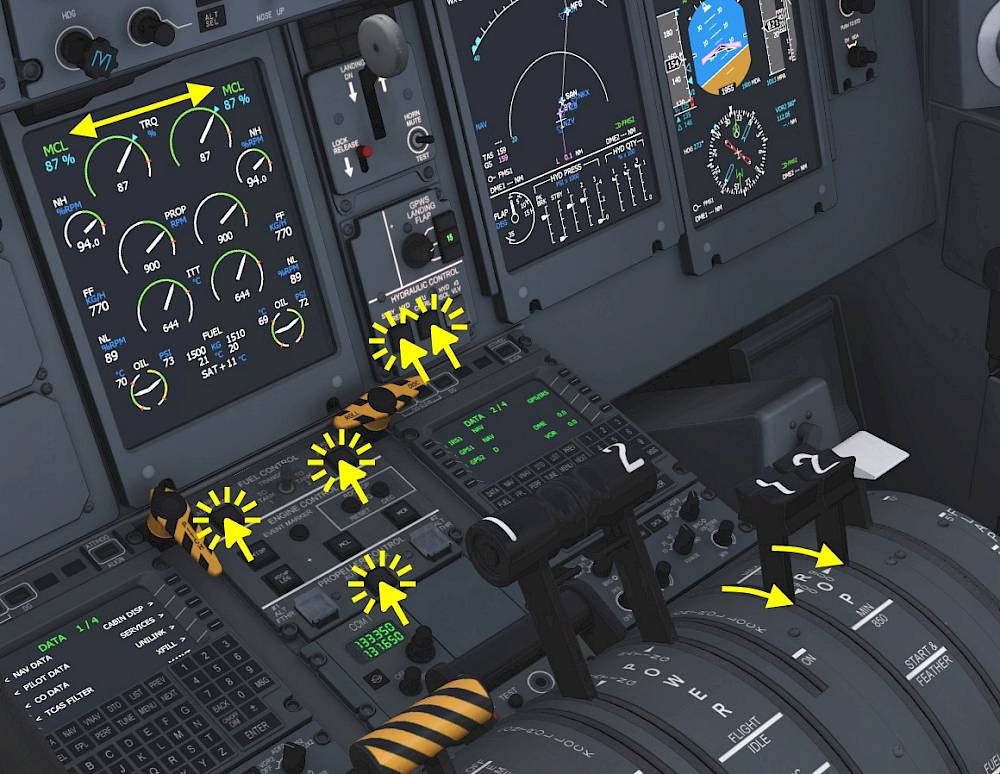
We have already retracted the landing gear and flaps, now we will reduce the power for climb.
And then, finally, we’re cleaning up the aircraft after the takeoff.
| After Takeoff Checklist | |||||
|---|---|---|---|---|---|
| No. | Location | Panel Name | Action | Remarks | |
| 1 | Front Panel | LANDING GEAR | LANDING GEAR | UP | |
| 2 | Pedestal | Throttle Quadrant | FLAPS | ZERO | Above V-FRI |
| 3 | Pedestal | Throttle Quadrant | PROP LEVER 1&2 | 900 | |
| 4 | Overhead | AIR CONDITIONING | BLEEDS | ON/NORM | |
| 5 | Front Panel | HYDRAULICS | STBY HYD PRESS | OFF | |
| 6 | Front Panel | HYDRAULICS | PTU CTRL | OFF | |
| 7 | Pedestal | PROPELLER CONTROL | AUTOFEATHER | OFF | |
| 8 | Pedestal | FUEL CONTROL | TANK 1&2 AUX PUMP | OFF | |
The flight plan is going to to a couple of slight turns now and only two and a half minutes into the flight we will already pass the San Diego VOR (“SAN”) on our route. from there on out we just climb straight and follow the coast to the north.

Once we passed the cumulus cloud tops it is safe to assume that there won’t be any turbulence. Depending on the weather settings the turbulence might be slight enough to release the passengers from their seat. Our tutorial flight is so short that they only have a couple minutes anyway.
We can then also close the engine intake flaps (inertial separator) since it’s unlikely we will encounter any birds or other debris.

At 10,000ft we turn off the lights and release the passengers.

Above transition altitude (18,000ft in USA, about 7,000ft in Europe) we switch to the global standard pressure of 1013 hPa or 29.92 InHg. In this tutorial this won’t be necessary as we are flying in the USA and stay below the 18,000ft anyway.
| Climb Checklist | |||||
|---|---|---|---|---|---|
| No. | Location | Panel Name | Action | Remarks | |
| 1 | Overhead | Signs | FASTEN BELTS | AS REQUIRED | |
| 2 | Front Panel | PFD | ALTIMETERS | SET STD | Above transition altitude |
| 3 | Overhead | EXTERNAL LIGHTS | LANDING | OFF | Above 10,000 ft |
| 4 | Overhead | EXTERNAL LIGHTS | FLARE | OFF | Above 10,000 ft |
| 5 | Overhead | ICE PROTECTION | ENGINE INTAKE 1&2 | SET CLOSED | Above cumulus cloud tops |
Upon reaching cruise altitude the autopilot will start to nose forward and capture the selected altitude (because we manually armed ALT SEL before). The altitude capture is indicated by ALT* on the top right corner, followed by ALT once captured. At this point the aircraft will start accelerating.
In this short hop from San Diego to Los Angeles the cruise will be very short. After the turn at NFG it’s already time to think about the descent. (Don’t forget to synchronize the heading after the turn…). So let us plan ahead and prepare the descent and approach into the destination airport now.
We’re heading into KLAX which has a field elevation of 124ft. We planned to fly a direct entry to the ILS approach for runway 25R, the ILS frequency is 111.10 MHz and the Course is 250°, both of which will be tuned automatically by the FMS since the ARCDU mode selectors are set in the FMS position. Decision height is 120ft which is CAT II and we’re using the autopilot and FD DUAL down to minimums and land manually, as always in the Q400. We’re going to use flap 15 for landing that gives us a VREF of 122kts.
We can descent down to roughly 2500ft above the destination airport elevation. For KLAX this would mean around 2620 feet. We’re going to round that up a little bit because we want to have more time on the final approach so we’re using 3000ft in this tutorial. Anything between 2500ft and 3000ft would be good here if you plan to repeat the flight. The lower the altitude you select the less time you have to prepare the aircraft and you will need more aggressive corrections down low. If you stay up near the glide slope (roughly 3000ft above the airport at the final turn) and slow down in time it will be quite a relaxed approach.
We’re letting the autopilot and FMS figure out when we need to descent and will use the vertical navigation (VNAV) functionality for this in this tutorial. In the real world VNAV isn’t used that often, typically ATC has other plans for us so we have to fall back to indicated airspeed hold (IAS) or vertical speed (VS) hold.

Now that we know the autopilot will start to descent on its own we can do other tasks. When the Top Of Descent (TOD) on the navigation display (small white circle with a

The cabin pressurization controller needs to know the landing altitude to schedule the cabin rate correctly.

For our own reference we’re going to set the solid cyan triangle to the approach reference speed. We can fly this speed in the final approach and use it as a guide/reference for our power management. During the approach we want our airspeed to stay at or above V-REF.

The final step for the approach preparation is to set the decision height (DH). We’re going to use a fantasy 120ft category 2 height. In the ILS approach we are not allowed to descent below this height above ground if we don’t have the runway in sight. If we don’t see at least the approach lights of the runway though the thick fog we have to go around and the missed approach procedure. But we chose clear weather for this flight so this won’t be an issue. If we look outside the windows we can already see L.A.
| Descent Preparation Checklist | |||||
|---|---|---|---|---|---|
| No. | Location | Panel Name | Action | Remarks | |
| 1 | Overhead | PRESSURIZATION | LANDING ALTITUDE | FIELD ELEV. SET | KLAX is at 124ft |
| 2 | Front Panel | GPWS | LANDING FLAP | AS REQUIRED | We're going to use flap 15 for this tutorial, no action required |
| 3 | Front Panel | PFDs (left and right) | V-SPEEDS | SET | set 122kts for flap 15 and current mass |
| 4 | Front Panel | PFDs (left and right) | DH/MDA | SET | DH 120ft in this tutorial |
With the VNAV descent armed and close to the
Note - Don’t reduce the throttle too much because the Q400 doesn’t like a power lever angle below FLT IDLE, as mentioned above. And the huge Props on this aircraft act like airbrakes, keep the power up until touch down or you really start to slow down and drop like a rock (well almost but you get the point). For the descent we used about 28% torque during the descent but this might change with next versions.
Once the autopilot pitched down the nose to initiate the descent we have to watch the speed of the aircraft even closer. With decreasing altitude the maximum airspeed will decrease below roughly 10,000ft. The red band on the speed tape will begin to come dow, if we have to stay below 240kts we should be good. For some extra safety and protection against bird damage (not yet simulated) we will keep the speed at least 10kts below maximum operating speed (VMO).

When we descent below the transition level (18,000ft in USA, about 7000ft in Europe) we switch back to local airport altimeter setting (QNH). In this tutorial this won’t be necessary as we are flying in the USA but stay below the 18,000ft anyway.
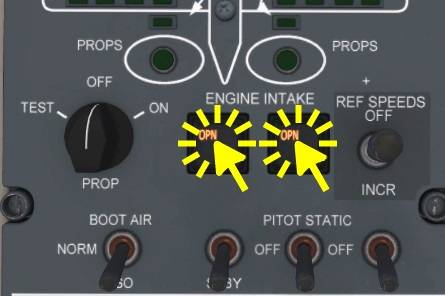

During the descent, when below 10,000ft

We’re descending to our destination airport and are only about 7000ft high at this point. On the Navigation Display page (ND) of the Multi Function Display (MFD) we can see the last waypoint coming into view at roughly 15 NM, time to prepare the approach.
| Descent Checklist | |||||
|---|---|---|---|---|---|
| No. | Location | Panel Name | Action | Remarks | |
| 1 | Front Panel | PFD P&FO | ALTIMETERS | SET LOCAL QNH | Below transition level |
| 2 | Overhead | Signs | FASTEN BELTS | SET ON | No later than 10,000ft |
| 3 | Overhead | EXTERNAL LIGHTS | APPROACH | ON | Below 10,000 ft |
| 4 | Overhead | EXTERNAL LIGHTS | FLARE | ON | Below 10,000 ft |
| 5 | Overhead | ICE PROTECTION | ENGINE INTAKE 1&2 | SET OPN | Below cumulus cloud tops |
Since the last turn of our flight from San Diego to Los Angeles Intl. is approaching rapidly we should begin to prepare the approach and arm the localizer and glide slope capture.

We now want to use the ILS receiver to fly the approach. Our autopilot is currently flying the route in LNAV mode and we want to keep it that way for now. That’s why we set up the ILS on the right side first.
For our tutorial flight the PFD should show “ICFN” on the legend to the right of the display, the course of 250° should be set automatically.

With the ILS2 selected on the right side PFD the display should look similarly to the screenshot below. To the right of the PFD we see the selected NAV SOURCE which we set to ILS2. Course has been set by the auto-tuning to 250° which should be correct for the ILS 25R into KLAX.
The HSI on the bottom center shows the localizer deflection. We’re heading to roughly 294° and the localizer and runway course are about 250°, so roughly a 45° intercept. As we come closer to the localizer the course deviation indicator will move towards the center as shown with the arrow.
To the right of the attitude you find your typical glide slope diamond, currently indicating that we are slightly below the 3° ILS glide.

To confirm we receive the ILS on our side as well (NAV1 receiver) we can use a little trick in the Q400. We have the option to display the localizer deflection on our MFD. To so so we have to hold down the “FORMAT” button on the EFIS control panel for one second.

As you can see on the screenshot we can see the deflection of the NAV1 receiver, currently tuned into 111.10 MHz (ILS1) and set to the course of 250°, displayed in the top right corner. This confirms we have the ILS tuned correctly and can use it in a second.
To leave this view and return to the map mode either
To intercept the localizer smoothly we’re going to use the HDG SEL function and Vertical Speed (VS) with our current heading and a vertical speed of -1000ft/min. Keep your torque at roughly 23% for now to help us slow down gently. Don’t let the speed drop too much at this point, we don’t want to waste our time here. With 200 to 220 kts you’re doing just fine for now.



Note - The left PFD should now display in the flight mode annunciator (FMA): HDG SEL, LOC (white) and VS -1000, ALT SEL (white) and GS (white). The Glide Slope (GS) can only engage when the localizer is already in capturing mode (LOC*) or localizer track (LOC). During testing the “ALT SEL” usually captured first and the vertical mode changed from VS to ALT* (altitude acquire) followed by ALT (altitude hold). This is not a big problem as GS will remain armed in white and capture the glide slope (GS*) as soon as possible.

Whilst the autopilot could be capturing the glide slope, let us quickly do a few remaining items on the to-do list.
On the hydraulics panel just below the gear lever
Below the engine display and in front of the throttle quadrant:
| Approach Checklist | |||||
|---|---|---|---|---|---|
| No. | Location | Panel Name | Action | Remarks | |
| 1 | Pedestal | FUEL CONTROL | TANK 1&2 AUX PUMP | ON | |
| 2 | Front Panel | HYDRAULICS | STBY HYD PRESS | ON | |
| 3 | Front Panel | HYDRAULICS | PTU CTRL | ON | |

The autopilot switches to LOC* and starts turning to the left to establish the aircraft on the localizer. The glide slope will be captured shortly after that.
Synchronize the selected heading
In case of a go around we would want to have a good reference to maintain runway heading.
Once the needle of the localizer starts moving we know that we are about to do the last turn and since the glide slope is also already off it’s maximum deflection it’s time for us to reduce speed further. Since the altitude captured and we didn’t increase power the speed is already dropping a bit. Let it drop to about 180 kts. Once the glide slope captures you need to reduce power. Set FLT IDLE if speed is getting away.
Note - Don’t move the power levers below FLT IDLE in the entire flight, unless you want to hear the full beauty of the beta warning horn that goes like this “WioWioWio”.
When the aircraft levels out onto the ILS course the glide slope should engage any second. We should be below 200kts, select flaps 5°. Continue slowing down to 160 kts.

At around 2000ft radar altitude (RA) (displayed on the PFD at the bottom of the attitude indicator, small white text on black background) we’re selecting gear down. When speed is below 181kts we can also extend the flaps to 10 degrees. Increase power now, we added a lot of drag, we want to keep the speed at 145 or so.
Note - The Q400 is equipped with a gear warning horn. If the gear is not down and the aircraft things it should be (e.g. power lever low and RA low) then a constant warning horn will sound. “BEEEP”
Re-trim the rudder so that the side slip is zero. This also helps the localizer tracking by the autopilot.
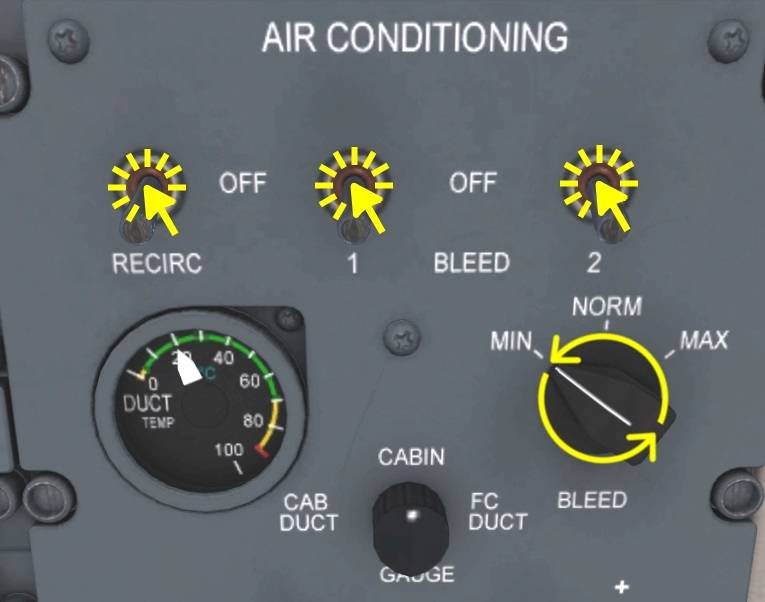
When speed is stabilized look up to the overhead panel and set the bleed strength to MIN. This increases engine performance which we would need in case of a go-around. In L.A. the go-around is not difficult, there are not mountains near the airport that we would have to climb over. In front of us is just the Pacific Ocean, so we can leave the engine bleeds on but we’re going to reduce the demand by setting the strength to MIN.

At around 1500ft RA set flaps to 15 (check that speed is below 172kts), which is our final stage of flaps for the very long runway in L.A. we could even land with flaps 10 if we wanted but we want to try get off the runway quickly as well, since we’re going to park near the middle of the terminal.
Maintain a speed of around 135 kts now. The final approach reference speed (V-REF), as mentioned and set as V-Speed before, is around 122kts in this configuration. Time to run the landing checklist.
Note - If you want to be even more realistic for this landing and use flaps 10 or want to test out flaps 35 remember to adjust the GPWS LANDING FLAP knob. The Ground Proximity Warning System (GPWS) will otherwise warn you about your flap configuration on short final.
| Landing Checklist | |||||
|---|---|---|---|---|---|
| No. | Location | Panel Name | Action | Remarks | |
| 1 | Front Panel | LANDING GEAR | LANDING GEAR | DOWN 3 GREEN | |
| 2 | Pedestal | Throttle Quadrant | PROP LEVER 1&2 | MAX 1020 | |
| 3 | Pedestal | Throttle Quadrant | FLAPS | SET/INDICATING | Select 15° and verify position |
| 4 | Overhead | AIR CONDITIONING | BLEEDS | ON/MIN | |
With the ILS1 and ILS2 set to the same frequency, same course and good signal, ILS1 and ILS2 selected as navigation sources and LOC and GS captured the PFDs will show “DUAL FD” up and right of the attitude indicator. The HSI SEL button on the Flight Guidance Control Panel (FGCP) points left and right indicating that the autopilot is using both navigation receivers. In case one LOC or GS is lost on either PFD the HSI will switch to the remaining good side to keep the approach.
Additional requirements for the category 2 ILS approach with this DUAL FD mode are two identical decision heights on left and right PFD, both below 200ft (CAT 2) and, of course, working radar altimeters.
This DUAL FD fail→active, fail→passive behavior is modeled in the Aerofly FS Q400, if you re-tune one receiver for example or switch the NAV-source on one side away from ILS. In case the capability of the aircraft to fly the ILS 2 approach drops (e.g. one NAV-source is set to the wrong position) a CAT 2 FAIL message is displayed. Then your approach minimums change and you might need to go around.
At 1000ft slowly reduce the speed to V-REF (122kts), use only small power adjustments. Perform final touches to the rudder trim. Enjoy the ride, we’re not going to do anything until we reach the decision height of 120ft.

At this point we have to decide if we have the runway or runway approach lights in sight to be able to continue the approach visually. We have very good weather, so no need to go around at this point for that reason. If your speed isn’t stable between 122 (VREF) and 132kts (VREF + 10kts) you might want to consider going around.
We have to disconnect the autopilot at this point anyway, if you think you can manage the landing continue, if it looks chaotic go around.
To disconnect the autopilot you can do several things.

Different to a lot of other aircraft you mustn’t pull power back to FLT IDLE or even DISC (your throttle at idle). The large props of this aircraft accelerate the air and push it onto the wing. Therefor the wing sees a faster airspeed behind the propeller and is also creating more lift. If you pull the power lever to FLT IDLE at this point the props will actually slow the air and act a bit like wind mills. Not only does the drag increase dramatically also your lift decreases a lot, and you fall from the sky and have a hard landing.
Instead, keep your approach power (roughly 20%) during the entire flare, until the aircraft has settled down.

With the main gear on the ground pull your throttle lever all the way back to idle. This moves the power levers to DISC in the simulator and the propellers are pitched to 0° flat. In this position they help us slowing the aircraft without needing too much brakes actually. With the power at idle the ground spoilers also extend and help to dump the remaining lift. This increases the down force and thus breaking action and also adds a little bit of aerodynamic drag.
On a short runway you can also use reverse thrust where the prop is pitches backwards and actively pushes air forward. This is pretty loud in the real world and it also can cause small stones to be thrown forward and damage the props or antennas in the forward section. In short: Shouldn’t be done on a regular basis but this is a sim, right? No small stones simulated yet and where is the fun if you can’t use full reverse and try to do the shortest landing possible…
Note - Due to an imperfection in the current governor you will need to tap the reverser key or button once or move your axis in the reverse ever so slightly. This will make the prop flip to DISC and give you a much better braking force.

Use your pedals or, if you don’t have any, use your assigned brake key or button (default key “b”). Touch the brakes gently, don’t hold full brakes as this would be quite unrealistic and would typically only be done on short runways or emergencies. Real aircraft would need maintenance a lot more often due to brake wear…
Try to take the second high speed exit off the runway to the right. (The one after a small concrete patch to the right of the runway, ending directly behind that parked British Airways aircraft). This should take only slight to moderate braking and we’ll end up right in front of the terminal where we want to park.
With the little trick (tapping the reverser key once) we could turn off the second exit whilst testing without braking at all in our testing with the current version of the Aerofly FS.

Do a quick look up to the EXTERNAL LIGHTS panel in the overhead and turn off the APPROACH and FLARE landing lights. Set taxi lights to ON.
Slow down on the taxi way leading and can keep the speed moderately high (35kts when exiting). When you exit the runway (passing over the hold short lines) your speed should be below 20kts again.
Now that we have crossed the hold short line completely we may stop and clear up the aircraft after landing. We have already set off the landing lights so no one will be blinded by them on the ground.


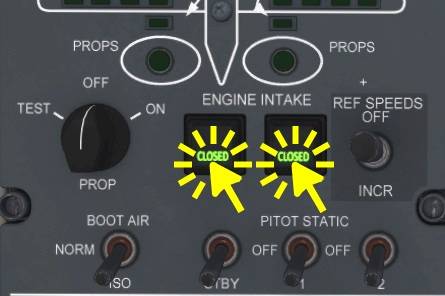
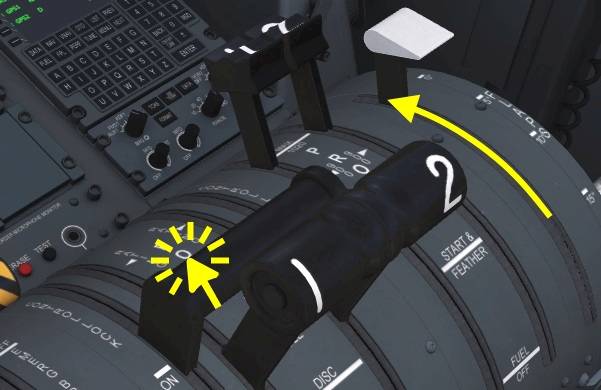

On the FUEL CONTROL panel (below the engine display):

Look up to the upper left corner of the overhead panel. On the DC Control Panel
| After Landing Checklist | |||||
|---|---|---|---|---|---|
| No. | Location | Panel Name | Action | Remarks | |
| 1 | Overhead | EXTERNAL LIGHTS | LANDING | OFF | |
| 2 | Overhead | EXTERNAL LIGHTS | TAXI | ON | |
| 3 | Overhead | EXTERNAL LIGHTS | ANTI COLLISION | ON RED | |
| 4 | Overhead | ICE PROTECTION | ENGINE INTAKE 1&2 | SET CLOSED | |
| 5 | Glareshield | Autopilot | YD (YAW DAMPER) | OFF | |
| 6 | Glareshield | SPOILERS | FLIGHT/TAXI | TAXI | |
| 7 | Pedestal | Throttle Quadrant | FLAPS | ZERO | |
| 8 | Pedestal | Throttle Quadrant | CONTROL LOCK | ON | |
| 9 | Pedestal | FUEL CONTROL | TANK 1&2 AUX PUMP | OFF | |
| 10 | Pedestal | WEATHER RADAR | MODE | STBY | |
| 11 | Pedestal | ARCDU | ATC/TCAS | STANDBY | Hold down lower right line select button |
| 12 | Overhead | DC CONTROL | MAIN BUS TIE | TIE | |
Turn off the taxi lights when you are turning into your parking position. In the real world you would blend ground personnel. If you exited at the same high speed taxi way you can now take any stand (not “gate”) that you like. We would suggest the one opposite of the other Q400 and right next to the parked ATR 42 regional aircraft. This might not be a realistic position for our horizon airline livery but, hey it looks cool, alright?
Short notice: Gates are where passengers wait, there may be multiple gates per passenger bridge or you might wait at a gate and then be picked up by a bus and driven across the entire airport to get to the stand where the aircraft is parked…

I’ll leave you with the parking and shut down procedure. From previous screenshots and the entirety of this tutorial you might be able to do this one on your own. You have seen all of the switches and buttons for this before and a lot of the fun in simulation also comes by experimenting on your own, play around a bit.
| Parking And Shut Down Procedure | |||||
|---|---|---|---|---|---|
| No. | Location | Panel Name | Action | Remarks | |
| 1 | Pedestal | Throttle Quadrant | PARKING BRAKE | ON | |
| 2 | Front Panel | HYDRAULICS | STBY HYD PRESS | OFF | |
| 3 | Front Panel | HYDRAULICS | PTU CTRL | OFF | |
| 4 | Pilot Panel | Switching Panel | STEERING | OFF | |
| 5 | Pedestal | Throttle Quadrant | PROP LEVER 1&2 | START&FEATHER | Start 30s cool down timer |
| 6 | Pedestal | WEATHER RADAR | MODE | OFF | |
| 7 | Overhead | APU CONTROL | PWR | ON | Wait for self test |
| 8 | Overhead | APU CONTROL | START | ON | Wait for green RUN |
| 9 | Overhead | APU CONTROL | GEN | ON | |
| 10 | Overhead | APU CONTROL | BLEED AIR | ON | |
| 11 | Overhead | AIR CONDITIONING | BLEEDS | OFF | |
| 12 | Pedestal | Throttle Quadrant | PROP LEVER 1&2 | CUT OFF | After 30s cool down timer |
| 13 | Overhead | Signs | FASTEN BELTS | OFF | |
| 14 | Overhead | EXTERNAL LIGHTS | ANTI COLLISION | OFF | When props stopped |
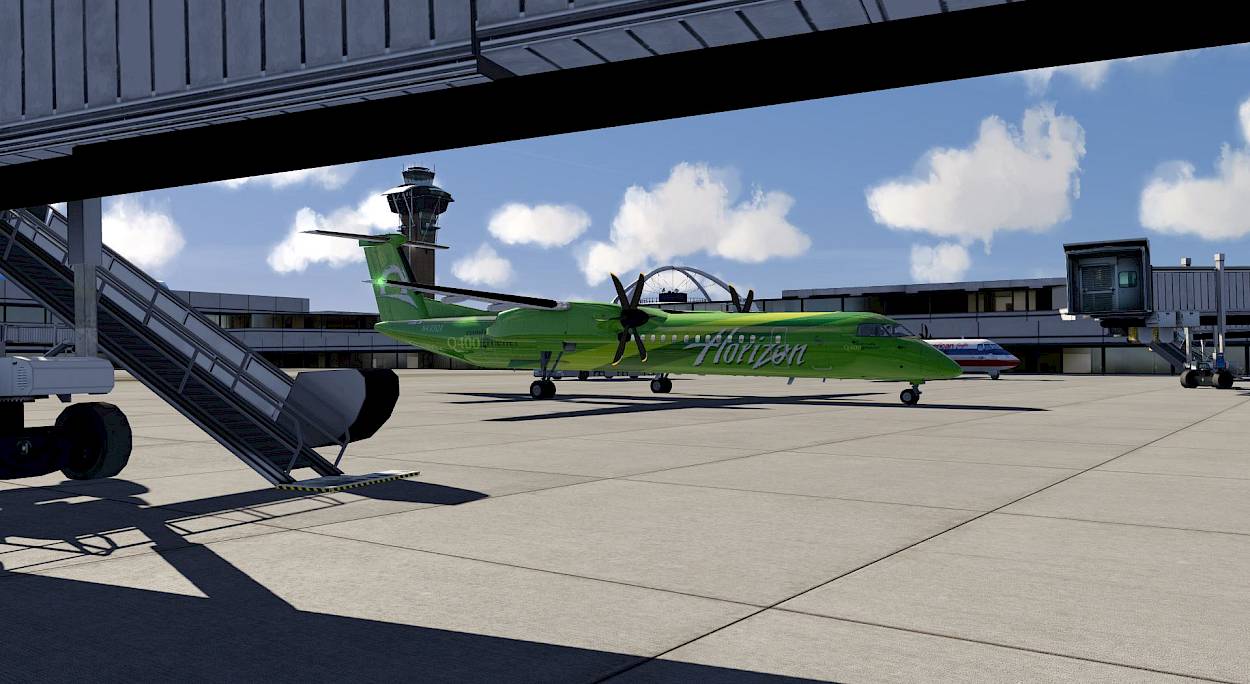
A quick recap of this flight my be good to close off this tutorial. We started the engines, configured the aircraft for takeoff, took off from KSAN in HDG SEL and engaged LNAV right after takeoff. We then accelerated to 210 kts and reduced the RPM of the props. Reaching the cruise altitude of 15000ft the autopilot leveled off because we manually armed ALT SEL, we reduced power and changed to 850 RPM. Then we prepared VNAV and planned the approach into KLAX, captured the localizer and glide slope, slowed down and configured the aircraft for landing. As always in the Q400 we landed the aircraft manually and vacated the runway, cleaned up the aircraft and taxied to one of the many parking positions at LAX. Then we shut down the engines and are now ready for the next flight.
What you could do next is either a flight back to San Diego, repeat the same flight again until you feel more comfortable or start a totally different flight, it’s up to you. I hope this tutorial provided you with enough info to fly the Q400 on your own.
Don’t forget to readjust power, trim, heading, ALT SEL, power above FLT IDLE, gear down in time, flaps for takeoff and not even full flaps for landing and the Q400 won’t bite you!

Explanations for the CRJ-900, Learjet 45, Dash8-Q400 and King Air C90GTx autopilots.

In our special tutorial for the UNS-1 FMS you will learn how to enter a flight plan for the 737-500, LJ45 and Q400 in the cockpit.

Check out the dedicated product page of the Q400 to get an overview about its features, see more screenshots and find more details about this aircraft in Aerofly FS.

We’re explaining the cockpit instruments, features and functionality of the Dash8-Q400 in our flightdeck guide.

The checklists used in this tutorial can be found on this dedicated page.

Find more interesting tutorials to read on our tutorials main page.